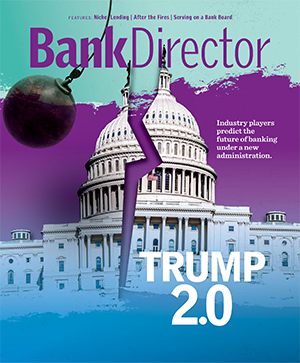
Always Have a Plan in Place for Raising Capital
Having a blueprint for selling stock or issuing debt can position banks to respond more nimbly to the 2025 M&A market.
Brought to you by Barack Ferrazzano Kirschbaum & Nagelberg LLP

While recently the industry focus has been on the historically low number of mergers and acquisitions, the capital markets have also been muted. Lower organic growth, margin compression, interest rate and economic uncertainty and depressed stock prices have all played a role in the lack of capital transactions in the industry. As the M&A market shows signs of a significant bounce in 2025, more institutions are considering their capital levels and whether they need to prepare for a possible offering.
One significant factor that may lead to a surge in capital raises is the flurry of subordinated debt issuances in 2020 and 2021. During those years, financial institutions issued billions of dollars of sub debt in public and private transactions. In general, the debt was structured as a 10-year fixed-to-floating instrument, with the yield fixed for only the first five years. In an historically low interest rate environment at that time, banks were able to issue sub debt at extremely low yields — we had some clients issue in the low 3% range. In the next six months, these debt instruments will begin to reprice substantially higher given the current rate environment.
One third-party estimated that, by the end of 2026, approximately $65 billion of sub debt will reprice. To refinance their outstanding debt, banks may consider an opportunistic capital raise, either by selling common stock, if pricing is advantageous, or by issuing preferred stock or subordinated debt if the Federal Reserve continues to lower interest rates and investor appetite exists. One challenge for another round of sub debt is that bank holding companies were active investors in the prior issuances — that may not be the case this time around.
In addition, we are seeing institutions raise capital to help restructure their balance sheets, primarily to sell underwater bonds and to redeploy those proceeds and any excess capital into higher-yielding securities. Banks are also repaying outstanding balances under the Federal Reserve’s Bank Term Funding Program and other high-cost borrowings. Although many banks are repositioning their balance sheets in this manner slowly over time without raising capital, it may be prudent for a board of directors to evaluate whether a large, one-time approach (similar to the one taken by some banks to deal with problem loans during the Financial Crisis) is preferable.
Financial institutions should evaluate their capital needs and be prepared to take advantage of market opportunities. We recommend that institutions proactively:
- Evaluate their capital stacks — senior and subordinated debt, preferred and common stock, etc. — Tier 1 and Tier 2 capital needs, debt-to-equity levels and update their capital plans as appropriate.
- Consider what communications, if any, should be had with the banking regulators prior to a capital raise.
- Seek the input of a financial advisor to have up-to-date information on the markets and the institution’s options at any given time.
- Assess the potential sources of capital, whether it be around the board table, existing shareholders, institutional investors or broader offerings.
- Evaluate the institution’s incorporation documents to confirm there is a sufficient number of authorized shares of capital stock for a potential raise. If not, consider seeking approval for an amendment at the 2025 annual shareholder meeting.
- Evaluate any contract, regulatory compliance or lending issue that should be cleaned up prior to an offering. Consider the due diligence and disclosure obligations that may factor into these decisions.
- If the institution is registered with the Securities and Exchange Commission, confirm whether a current shelf registration statement is on file, that it hasn’t expired and that it has a sufficient dollar amount of securities registered for a potential issuance.
Being prepared for a capital raise will allow banks to move quickly and efficiently in response to market opportunities should the need for additional or replacement capital arise. This preparation, coupled with proactive planning for the institution’s possible participation in the developing M&A market, will provide an institution with maximum flexibility to react to the environment in 2025.



